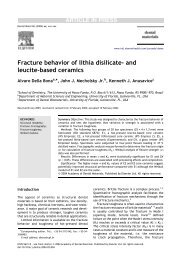Micro-tensile bond strength of adhesives bonded to class-I cavity ...
Micro-tensile bond strength of adhesives bonded to class-I cavity ...
Micro-tensile bond strength of adhesives bonded to class-I cavity ...
You also want an ePaper? Increase the reach of your titles
YUMPU automatically turns print PDFs into web optimized ePapers that Google loves.
<strong>Micro</strong>-<strong>tensile</strong> <strong>bond</strong> <strong>strength</strong> <strong>of</strong> <strong>adhesives</strong> <strong>bond</strong>ed <strong>to</strong> <strong>class</strong>-I <strong>cavity</strong>-bot<strong>to</strong>m dentin after thermo-cycling 1007<br />
[17] Abe Y, Lambrechts P, Inoue S, Braem MJA, Takeuchi M,<br />
Vanherle G, et al. Dynamic elastic modulus <strong>of</strong> ‘packable’<br />
composites. Dent Mater 2001;17:520–5.<br />
[18] Blunck U, Roulet JF. Effect <strong>of</strong> one-year water s<strong>to</strong>rage on the<br />
effectiveness <strong>of</strong> dentin <strong>adhesives</strong> in <strong>class</strong> V composite resin<br />
res<strong>to</strong>rations. J Dent Res 2002;81 [Special Issue B, abstr.<br />
946].<br />
[19] Frankenberger R, Strobel WO, Krämer N, Lohbauer U,<br />
Winterscheidt J, Winterscheidt B. Evaluation <strong>of</strong> the fatigue<br />
behavior <strong>of</strong> the resin–dentin <strong>bond</strong> with the use <strong>of</strong> different<br />
methods. J Biomed Mater Res Part B: Appl Biomater 2003;<br />
67B:712–21.<br />
[20] Krejci I, Häusler T, Sägesser D, Lutz F. New <strong>adhesives</strong> in<br />
<strong>class</strong> V res<strong>to</strong>rations under combined load and simulated<br />
dentinal fluid. Dent Mater 1994;10:331–5.<br />
[21] Armstrong SR, Keller JC, Boyer DB. Mode <strong>of</strong> failure in the<br />
dentin–adhesive resin–resin composite <strong>bond</strong>ed joint as<br />
determined by <strong>strength</strong>-based (mTBS) and fracture-based<br />
(CNSB) mechanical testing. Dent Mater 2001;17:201–10.<br />
[22] Armstrong SR, Keller JC, Boyer DB. The influence <strong>of</strong> water<br />
s<strong>to</strong>rage and C-fac<strong>to</strong>r on the dentin–resin composite micro<strong>tensile</strong><br />
<strong>bond</strong> <strong>strength</strong> and de<strong>bond</strong> pathway utilizing a<br />
filled and unfilled adhesive resin. Dent Mater 2001;17:<br />
268–76.<br />
[23] Armstrong SR, Vargas MA, Fang Q, Laffoon JE. <strong>Micro</strong><strong>tensile</strong><br />
<strong>bond</strong> <strong>strength</strong> <strong>of</strong> a <strong>to</strong>tal-etch 3-step, <strong>to</strong>tal-etch 2-step, selfetch<br />
2-step, and a self-etch 1-step dentin <strong>bond</strong>ing system<br />
through 15-month water s<strong>to</strong>rage. J Adhes Dent 2003;5:<br />
47–56.<br />
[24] Van Meerbeek B, Kanumilli P, De Munck J, Van Landuyt K,<br />
Lambrechts P, Peumans M. A Randomized controlled trial<br />
evaluating the three-year clinical effectiveness <strong>of</strong> two etch &<br />
rinse <strong>adhesives</strong> in cervical lesions. Oper Dent 2004; 29:376–85.<br />
[25] Boghosian A. Clinical evaluation <strong>of</strong> a filled adhesive system<br />
in Class 5 res<strong>to</strong>rations. Compend Contin Educ Dent 1996;17:<br />
750–4.<br />
[26] Sano H, Yoshikawa T, Pereira PN, Kanemura N, Morigami M,<br />
Tagami J, et al. Long-term durability <strong>of</strong> dentin <strong>bond</strong>s made<br />
with a self-etching primer, in vivo. J Dent Res 1999;78:<br />
906–11.<br />
[27] Takahashi A, Inoue S, Kawamo<strong>to</strong> C, Omina<strong>to</strong> R, Tanaka T,<br />
Sa<strong>to</strong> Y, et al. In vivo long-term durability <strong>of</strong> the <strong>bond</strong> <strong>to</strong><br />
dentin using two adhesive systems. J Adhes Dent 2002;4:<br />
151–9.<br />
[28] Van Meerbeek B, De Munck J, Yoshida Y, Inoue S, Vargas M,<br />
Vijay P, et al. Buonocore memorial lecture: adhesion <strong>to</strong><br />
enamel and dentin: current status and future challenges.<br />
Oper Dent 2003;28:215–35.<br />
[29] Türkün SL. Clinical evaluation <strong>of</strong> a self-etching and a onebottle<br />
adhesive system at two years. J Dent 2003;31:<br />
527–34.<br />
[30] Tay FR, Pashley DH, Suh BI, Carvalho RM, Itthagaruna A.<br />
Single-step <strong>adhesives</strong> are permeable membranes. J Dent<br />
2002;30:371–82.<br />
[31] Tay FR, King NM, Chan KM, Pashley DH. How can<br />
nanoleakage occur in self-etching adhesive systems that<br />
demineralize and infiltrate simultaneously? J Adhes Dent<br />
2002;4:255–69.<br />
[32] Van Meerbeek B, Van Landuyt K, De Munck J, Yoshida Y,<br />
Inoue S, Lambrechts P. Bonding effectiveness <strong>of</strong> experimental<br />
one-step self-etch <strong>adhesives</strong> <strong>to</strong> enamel and dentin.<br />
J Dent Res 2004;83 [Special issue B Abstract 0028].<br />
[33] Van Landuyt K, De Munck J, Snauwaert J, Coutinho E,<br />
Poitevin A, Yoshida Y, Inove S, Peumans M, Suzuki K,<br />
Lambrechts P, Van Meerbeek B. Monomer-solvent phaseseparation<br />
in contemporary one-step self-etch <strong>adhesives</strong>.<br />
J Dent Res 2005;84:183–8.
















